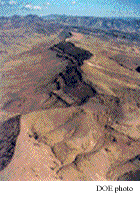
In the last 50 years the United States has produced approximately 30 million tons of high-level radioactive waste, mostly spent fuel from nuclear power reactors and radioactive debris from weapons production. The material, which will remain hazardous for more than two million years, has been temporarily stored at more than 100 sites across the nation. After 20 years of study, the federal government recommended in 2002 that Yucca Mountain, a remote site in the Nevada desert 100 miles northwest of Las Vegas, become the permanent repository for this dangerous waste. While critics question the project’s safety, proponents counter that the alternatives may be even more dangerous. Professor Peter Burns, chairman of Notre Dame’s department of civil engineering and geological sciences, has been involved in the Yucca Mountain Project for eight years. Recently, we talked with him about his work and the safety of Yucca Mountain.
Notre Dame Magazine: Why do you believe Yucca Mountain would be a safe place to store the nation’s high-level radioactive waste? Peter Burns_:_It’s very remote, and it’s very dry. If the repository is built, the radioactive waste would be surrounded by about 1,000 feet of very dense rock and be 1,000 feet above the water table. It’s hard to imagine significant radiation coming out of that mountain anytime soon.
NDM: You said “if it is built.” Is there a possibility the repository will not be built? Burns: There may be some back and forth negotiating between the Department of Energy and the U.S. Nuclear Regulatory Commission, but in all likelihood I think the NRC will license the repository, and it will be built. Right now the Yucca Mountain Project is preparing to apply to the NRC for a site license this fall. It will make the case why the DOE scientists believe Yucca Mountain would be a safe repository. Essentially the process is one arm of the federal government attempting to prove to another arm that the project is safe enough to go forward. It may go back and forth for some time, but, as I said, I think the NRC will license the repository. Then Yucca Mountain must apply for a construction license and get the different components of the construction approved. Only after this rigorous review can they build it and start putting the waste inside.
NDM: What’s your role in all of this? Burns:Our work is aimed at understanding how spent nuclear fuel will behave chemically under the environmental conditions of the repository. It’s important to know because at some point in the future it’s certain the canisters containing the radioactive waste will fail. It’s not a matter of “if” but “when.” And when that happens, which hopefully will be in the far distant future, the canisters will release the material inside the mountain where it will oxidize and chemically break down. The mountain then becomes the last barrier between the nuclear waste and the environment. So it’s important to know how this material will react in that environment. In particular we’re concerned with what happens to the element neptunium.
NDM: Why neptunium? Burns:Neptunium stays radioactive for a long, long time. It has a radioactive half-life of 2.14 million years, and it’s very soluble in water. As the radioactive waste chemically breaks down, we are most concerned how neptunium will be bound up chemically, and whether these so-called “alteration-phase compounds” are soluble in water.
There are a lot of ways radiation might be released from the mountain: A catastrophic volcanic event, human intrusion or a meteorite impact, for example. But these are all deemed to be extremely low probability. On the other hand, everyone agrees that at some point some level of radiation release through groundwater is a 100 percent certainty. It’s only a matter of time and whether that time frame is long enough for most of the radioactivity to have decayed away. So our work is aimed at understanding how the repository will perform in a 10,000- to 100,000-year time frame.
NDM: What have you learned so far? Burns:It appears that the normal sequence of chemistry events will significantly retard the release of neptunium by binding it up in insoluble compounds. Based on what we have been arguing, the Yucca Mountain Project has reduced the predicted radiation release rate by a factor of about one million, which is quite substantial.
NDM: Is there any urgency to the Yucca Mountain Project? Burns: The current situation in which the nation’s high-level radioactive waste is being temporarily stored at over 100 sites is flirting with disaster. There’s no question that Yucca Mountain is needed. In fact, we should be working on Yucca Mountain II. The repository was designed to hold 70,000 tons of waste. At current rates it will be full by 2010. That’s kind of worrisome.